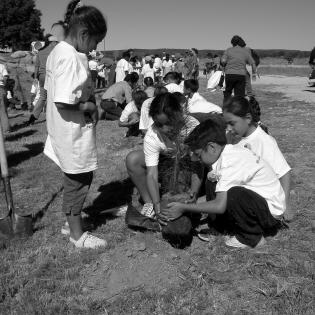Water, Glorious Water
Learners talk about the uses of water and understand its importance to our world.
- identify uses of water.
- state the civic responsibility of everyone to conserve water.
- read-aloud copy of the book, The Drop In My Drink: The Story of Water On Our Planet
- basic art materials
Maydak, Michael S., McKinney, Barbara Shaw. A Drop around the World. California: Dawn Publications, 1998. ISBN: 1883220718
Instructions
Anticipatory Set:
Talk about the group's experiences with water: How do you play and interact with water? Where do we see water in nature? What do you use water for? How do we get water to our houses?
Read the book, A Drop Around the World. Discuss what would happen if there was not enough water for our use and enjoyment.
Tell the children that in 2015-16 in Flint, Michigan, families were not able to use the local water because it wasn't safe. Discuss the water crisis in Flint. The details can be found online.
Discuss the things that families did in Flint to get and conserve water. They could not use the tap water for cleaning or drinking and cooking so they had to use bottled and filtered water very conservatively.
Many people around the country donated water and sent it to Flint. Talk about why people give in a crisis.
Make a co-created chart of their understanding of conservation and stewardship and use it to lead into their illustrations below. An anchor chart is an artifact that holds thoughts, ideas and processes in place. They collect what we know and serve as reminders of prior learning. Tell the learners that because there is only a limited supply of water on the Earth, we must conserve it, which means to use something carefully so as not to exhaust the supply.
Ask: "Who is responsible for conserving water or keeping the water we have clean and usable?" When we take care of the Earth’s resources we are being good stewards of the Earth. (Someone who takes care of the Earth and its resources.)
Distribute drawing paper and materials. Each learner illustrates their own favorite use of water. Discuss,“What could we do to make sure there is enough water to always use it safely?”
Display artwork to raise awareness of the importance of each of us caring for water resources. Display with the caption “If there was not enough clean water, I would not be able to …”
Letting others know how important it is to care for water is an act of advocacy, or using our voice to make a difference.
Philanthropy Framework
-
Strand PHIL.I Definitions of Philanthropy
-
Standard DP 01. Define Philanthropy
-
Benchmark E.3 Recognize that citizens have a responsibility for the common good as defined by democratic principles.
-
-
-
Strand PHIL.II Philanthropy and Civil Society
-
Standard PCS 03. Philanthropy and Economics
-
Benchmark E.13 Describe limited resources and scarcity.
-
Benchmark E.5 Recognize the wise use of resources as <i>stewardship</i>.
-
-
-
Strand PHIL.III Philanthropy and the Individual
-
Standard PI 01. Reasons for Individual Philanthropy
-
Benchmark E.1 Describe one reason why a person might give or volunteer.
-
-
